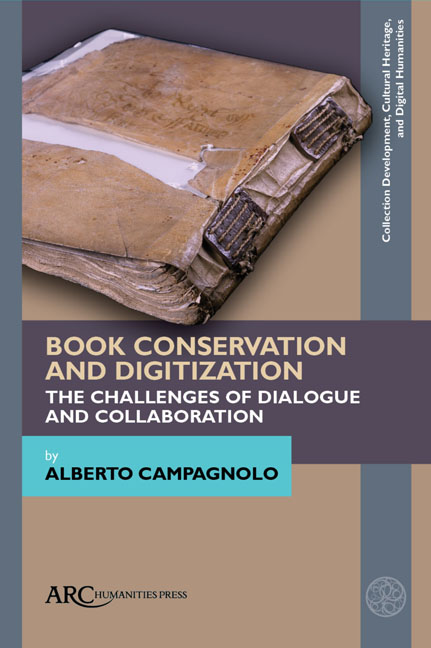Summary
Like men, books have a soul and a body. With the soul, or the literary portion, we have nothing to do at present; the body, which is the outer frame or covering, and without which the inner would be unusable, is the special work of the binder.
(William Blades, The Enemies of Books, 1902, p. 96)THE SUCCESSFUL TRANSMEDIATION of books and documents through digitization requires the synergetic partnership of many professional figures that have what may sometimes appear as conflicting goals at heart. On one side, there are those who look after the physical objects and strive to preserve them for the future generations— conservators and curators— and on the other those involved in the digitization of the objects, the information that they contain, and the management of the digital data— digitization professionals, and then digital humanists. These complementary activities are generally considered as separate, and when the current literature addresses both groups, it does so strictly within technical reports and guidelines, concentrating on procedures and optimal workflow, standards, and technical metadata. In particular, more often than not, conservation is presented as ancillary to digitization, with the role of the conservator restricted to the preparation of items for scanning, with no input into the digital product, and this leads to misunderstanding and clashes of interests.
Digitization projects have become increasingly crucial for memory institutions and cultural heritage in general and have been at the core of the field of digital humanities from its beginnings, inevitably with a profound influence on conservation practice since the early 2000s. Here, as hinted at in the title, we will be concerned with the digitization of books and documents. All the fields involved in this diverse practice landscape, besides the specifics included in technical manuals in regard with best-practice procedures, have largely distinct authorship and readerships that do not overlap. This book tries to fill this gap. It strives to do so by showcasing, on the one hand, the need to understand the informational content of books as objects and the role that conservators could have in the creation of broader digital products and tools, and, on the other, the transformative and transcendent value that digital surrogates can and should bring to the table.
- Type
- Chapter
- Information
- Book Conservation and DigitizationThe Challenges of Dialogue and Collaboration, pp. 1 - 14Publisher: Amsterdam University PressPrint publication year: 2020



